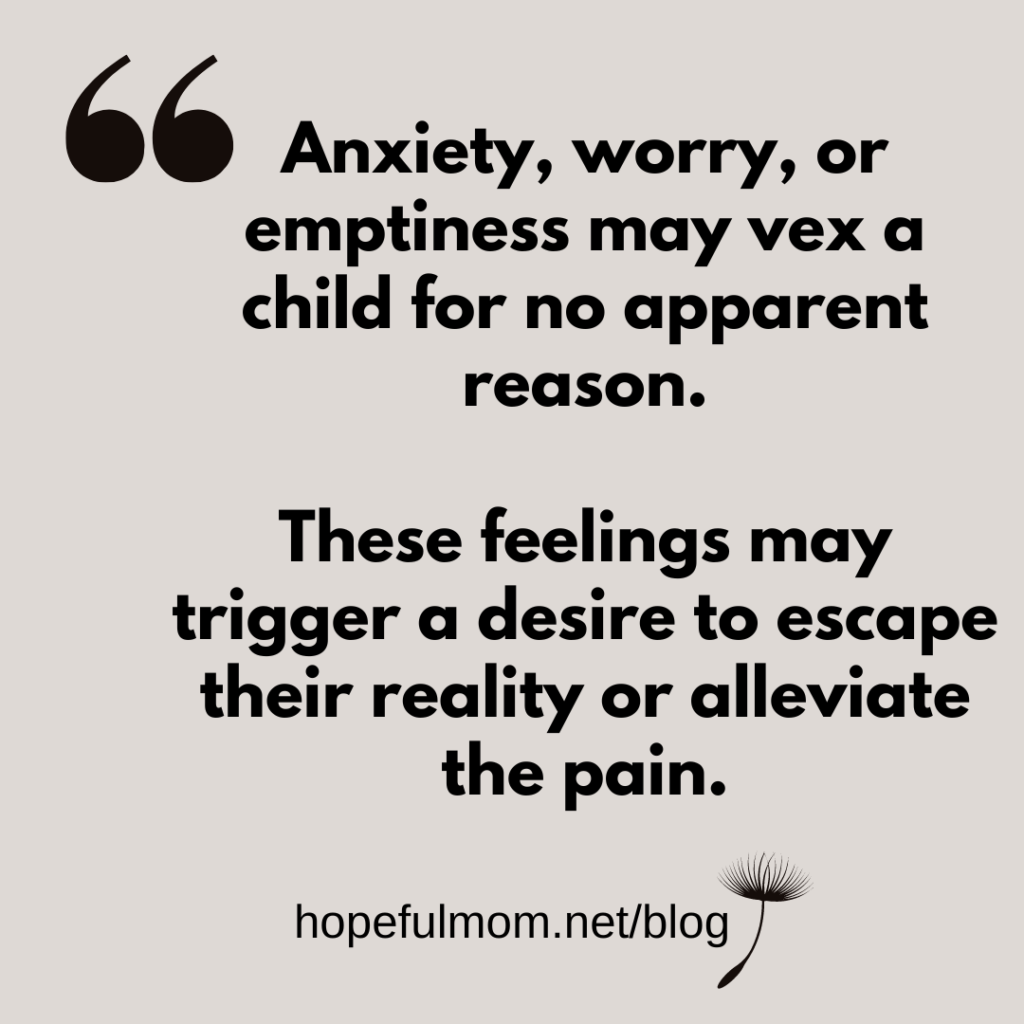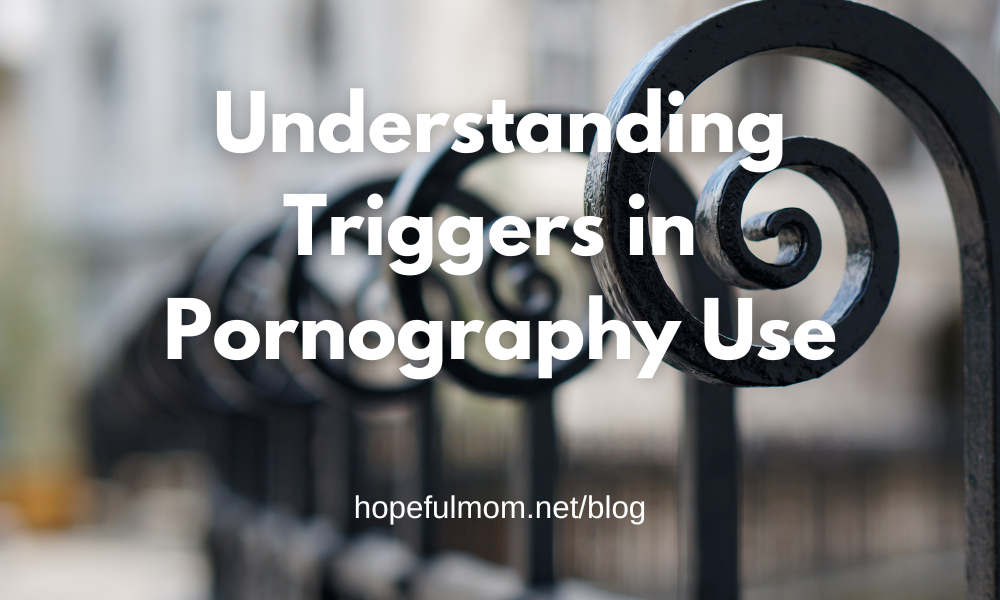“Why did you make this decision? And why do you keep going back when you know it’s harmful?” Most parents ask these questions when learning about a child’s indiscretions or habitual behavior. We are trying to discern their triggers.
In a previous post, we defined triggers as “anything, as an act or event, that serves as a stimulus and initiates or precipitates a reaction or series of reactions.”[i] In other words, a trigger is an outside stimulus that activates internal turmoil. In that post, we explored triggers parents face after learning of a child’s struggle with pornography.
In this post, we’ll examine the user’s triggers—to watch pornography or run to any type of vice or behavior to seek immediate comfort.
My son’s answer to the question why was, at times, because he was bored. Boredom wasn’t his initial motivation for watching porn, but it was a reason he returned to it over and over. This excuse seemed too simplistic for me at first. But after some research, I learned boredom is a common trigger for people who watch pornography.
As with all humans, our children may be going about their day when they experience anxiety, worry, or emptiness for no apparent reason. They feel the urge to escape their reality or fulfill a desire to alleviate pain or discomfort. Their instincts may be natural, but we want to help them identify the cause and turn from their compulsive behavior. The objective is to pinpoint the trigger, face it, and train their brain and body not to react.

What are some common triggers?
The answer to this question is complex. While a trigger could be an outside stimulus, it may have been provoked by an internal need. We’ll look at those needs in a minute.
For now, let’s put triggers into two categories, emotional and situational.
In BLAST Addiction with Emotional Awareness, Kristen Jenson of Defend Young Minds reminds us we can use the acronym BLAST to describe some of our negative emotions.
- Bored
- Lonely
- Angry
- Stressed
- Tired
- Let’s add in Hungry . . . because we’ve all been around people who make poor decisions or react badly when they’re hungry. Did you just raise your hand? I did.
Jenson tells us, “When children don’t learn healthy coping habits for dealing with their BLAST feelings, they may easily turn to distractions like food, video games, pornography, drugs or alcohol. Sadly, they have no idea that this kind of coping strategy can lead to addiction.”[ii]
Here are some possible trigger-inducing situational events:
- Seeing a sexy photo or person in real life. Keep in mind your child’s taste may differ from others. We can’t determine for someone else what should or should not stimulate desire.
- A particular place, like the beach or a party or a friend’s house. This could be the place in which they’ve seen pornography before or a place that may conjure up certain desires.
- A particular time of day, like bedtime. If your child is in the habit of watching pornography at the same time of day each day, their body may signal that it’s “time” for them to look up porn.
- An upsetting situation (i.e. parents arguing, friend bullying, not performing well on an assignment or in a sports event, social media incident).
How do I discern what my child’s triggers are?
Ask your child under what circumstances they are more likely to turn to pornography. Guide the conversation, if necessary, by sighting specific scenarios. Identify both emotional triggers and situational triggers. If appropriate, use examples from your own life.
Here are a few sample questions to get you started:
- Do you watch pornography when someone is mad at you? When you are anxious, lonely, bored, tired, or afraid?
- Are there specific settings which cause you to desire pornography? In the bathroom or bedroom? Certain commercials? Playing a specific game or listening to particular music? Hanging out with certain people or while scrolling social media?
- Are there specific times of day in which you are more likely to watch pornography? Before you get out of bed in the morning? After supper or late at night?
Hopefully, these questions start conversations which guide you and your child to discern triggers.
Anxiety, worry, or emptiness may vex a child for no apparent reason. These feelings may trigger a desire to escape their reality or alleviate the pain. #triggers #hopefulmom #fightthenewdrug Understanding Triggers in Pornography Use Share on XHow can I combat these triggers?
As with parent triggers, we want to identify the disruptive trigger(s) and develop a method to reduce their effects.
Let’s look at those internal needs. Ben Bennett and Josh McDowell of The Resolution Movement indicate we each have seven God-given longings: acceptance, appreciation, affection[iii], access (to the emotional and physical presence of key figures), attention, affirmation, and assurance of Safety[iv].
When these longings are met, the desire to look elsewhere for them diminishes.
As parents, we can help our children fill these cravings. But I recognize that even when we supply their needs, they may not receive them or perceive them as being available. Just keep trying.
In addition, consult with your child about establishing healthy boundaries and creating a plan for when they are triggered. Consider the following:
- Concentrate on breathing.
- Remove yourself from the situation.
- Re-focus your thoughts.
- Contact a trusted friend or adult.
- Exercise.
- Engage in a fulfilling activity (have a list available).
- Pray.
Pinpointing, managing, and resisting triggers is a process. As with our own triggers, the hope is to reduce the number of times our children are triggered. The time spent working through these steps is well worth it. Our children are worth it.
Let’s help each other and add to these lists. What are some other triggers? What have you learned helps combat triggers?
Thanks for reading! Subscribe below for updates and a FREE PDF: 7 Steps After Your Child Sees Porn. Connect on Facebook and Instagram. And please share on social media.
[i] https://www.dictionary.com/browse/trigger
[ii] https://www.defendyoungminds.com/post/blast-addiction-with-emotional-awareness
[iii] Ben Bennett, “The Foundation of a Thriving Life – The Seven Longings Part 1 – Episode 4,” Resolution Movement, June 11, 2020, https://resolutionmovement.org/episodes/the-foundation-of-a-thriving-life-the-seven-longings-part-1-episode-4/.
[iv] Ben Bennett, “The Foundation of a Thriving Life – The Seven Longings Part 2 – Episode 5,” Resolution Movement, June 4, 2020, https://resolutionmovement.org/episodes/the-foundation-of-a-thriving-life-the-seven-longings-part-2-episode-5/.
About the author
Barb Winters is the author of Sexpectations: Helping the Next Generation Navigate Healthy Relationships and founder of Hopeful Mom. She’s a certified mental health coach and offers one-on-one consultations for parents. For more about Barb, click "About" in the menu.




One Reply to “Understanding Triggers in Pornography Use”